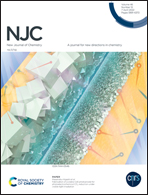Inclusion complexes of triblock L35 copolymer and hydroxyl propyl cyclodextrins: a physico-chemical study†
Abstract
In this work, we studied the formation of supramolecular inclusion complexes (pseudopolyrotaxanes) generated by the interactions between L35 Pluronic (PEO–PPO–PEO triblock copolymer) and hydroxyl propyl-modified cyclodextrins (HP-α-CD and HP-β-CD). The structural characteristics of the L35/CD composites were investigated by X-ray diffraction spectroscopy, which highlighted the effective inclusion of the copolymer. The thermodynamic properties of the pseudopolyrotaxanes were determined through density and speed of sound experiments conducted on aqueous mixtures with various L35/CD compositions, while turbidimetric analyses allowed the investigation of the kinetics of the threading process of L35 polymeric chains within the cavity of the cyclodextrins. Both thermodynamic and kinetic features were explored at various temperatures (20, 25, 30 and 35 °C). According to the negative values of the Gibbs free energies, we observed that the formation of the pseudopolyrotaxanes is spontaneous for both cyclodextrins. Specifically, the inclusion process is more favoured for HP-β-CD. This result was supported by the peculiar effects of the cyclodextrins on the interfacial characteristics of the copolymer at the air/water interface. In conclusion, this paper provides an extensive description of L35/HP-α-CD and L35/HP-β-CD complexes that have potential as thermo-sensitive nanocarriers with controlled release properties.



 Please wait while we load your content...
Please wait while we load your content...